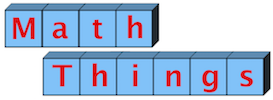Towers of Hanoi
I understand the origins of the Towers of Hanoi is derived from Southeast Asian creation lore. The Creator is playing the game with 64 disks instead of 8. When the game ends, so does the world.
A more manageable version includes 8 disks instead of 64. But it's made much more bite-sized by having students try it with 2 disks, then 3, and then with greater numbers.
The rules are as follows.
1. The picture shows 8 disks stacked on one spindle in order of size. There are 3 spindles.
2. The task is to replicate this stack on another spindle.
3. Move only one disk at a time.
4. You cannot place a larger disk on a smaller disk.
So, for instance, to move a 2-disk stack, you first place the top, smallest, disk on one of the empty spindles. Then you move the larger, bottom disk to the third spindle. Then you place the small disk on top of the larger one. Two disks, three moves.
The student’s job is to count accurately the minimum number of moves it takes to reproduce the stack for any given number of disks. This entirely depends on the student keeping accurate count of each move. I like to have a second student recording moves with tally marks.
The fact that students have to physically lift disks off one spindle and place them on another slows the game down and facilitates counting. But having a physical base with spindles requires either purchase of a commercial game, or a construction project. The template to the left allows stacks of disks to be placed on each ring. Students have to be extra careful to count the moves. My students use this with 2 and then 3 disks when they’re starting out.
Students who are meticulous and systematic in their movement and counting will find a pattern to the minimum number of moves required to reproduce the stack on another spindle. One disk requires 1 move, 2 disks require 3 moves, 3 disks require 7 moves,… But there is a second and more sophisticated rule that allows you to calculate the number of moves for x number of disks without writing out the whole sequence, and this involves exponents. That would be a good challenge for advanced elementary or middle school students.
The disks pictured above were cut from fiberboard with an adjustable hole cutter on a hand electric drill. If you have a drill press you’d probably be able to cut them from thicker material.
If you are not or don’t know a woodworker, you can make these with a variety of common school materials. Perhaps your school or district has a set of die cutters; some good school supply stores also do. This would give you perhaps 3 or more differently-sized circles. For the rest, you would probably need to cut them out with scissors. The thicker the material, the better, so students can grip it.



